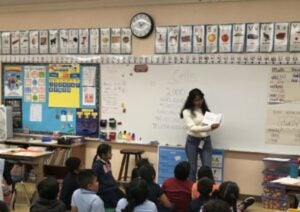 Community Connections – Yvonne Hernandez
Community Connections – Yvonne Hernandez
Introducing Yvonne Hernandez and Eduardo Lopez, first gen students and NAI scholars, from South Central and teaching in South Central. This is their story. – Originally Published April 1, 2020
Growing up in South Central I was not really exposed to the best resources to get excited about education. In elementary and middle school, the science portion exposed to me was little to non-existent. Because I was accepted into the USC Neighborhood Academic Initiative (NAI) program, I attended Saturday Academy. On these Saturdays, NAI would incorporate science classes. Here is where I was really exposed to science and all the fascinating experiments. One particular experiment that struck my interest in science was the cow eye dissection. I was never exposed to any real animal parts for the purpose of exploring it and learning about it. After cutting into the many layers of the eye and observing how it is structured, I was immediately interested in what other experiments NAI had to offer. Because NAI was there all throughout my middle and high school journey, exposing me to more science, my interest in it and in school in general increased.
Now, being part of the staff for the Joint Educational Project (JEP) and its Norris Comprehensive Cancer Center- (NCCC) sponsored Medical STEM Program (MSP), I am able to practice my passions within the same community that I grew up in but I am also able to really be who I am because of the people involved in the program. JEP’s MSP has really pushed me to become a better educator for the students. Knowing I have both the NAI family and JEP family by my side makes it a lot easier for a first-generation student to not only survive college but thrive in it.
With my own experience teaching kids, I realized that all kids are excited to learn, they just need someone to view them as capable of learning. I got the opportunity to teach two different classes. I co-taught medical- and cancer-themed topics with Ms. Robles’s class with Eduardo Lopez and then moved into Mr. Nakama’s classroom. Both were second grade classrooms, but they came with different teaching environments and very different teaching experiences. I did my best to really get the students interested in science.
One memorable moment I had with a student was when we were working the Dermatology unit –a unit that discusses skin layers, cancer, skin damages– more specifically the lesson on stitches. I was helping one student with his stitches. This student needs extra aid in the class because of characteristics that may classify him as autistic. With my help, he was able to complete the stitches in a neat manner. I got really excited for him and told him he was one step closer to becoming a scientist. When he heard this, his eyes lit up so brightly, his smile grew wider; he was so happy to hear this type of encouragement. After that experience, he was constantly helping me with the lessons. He would eagerly read the book for the class, and pass out papers from time to time. Even with little gestures, students are able to see when a teacher is there for them. I saw that treating students with respect can really change the way they see themselves. They begin to really believe that they are smart enough to learn very dense and heavy lessons.
By becoming a teacher, I will be able to be the person I needed growing up and will be able to support students who come from the same background as me. Having the opportunity to teach in my community is honestly everything to me. I value my community and anything that involves me giving back to the people that helped me become the young woman I am today. Through my experience with teaching young kids from my community, I really see the importance of education. Seeing all the things that education does for kids is something so remarkable that it made me realize that teaching is something I want to do as a career.
